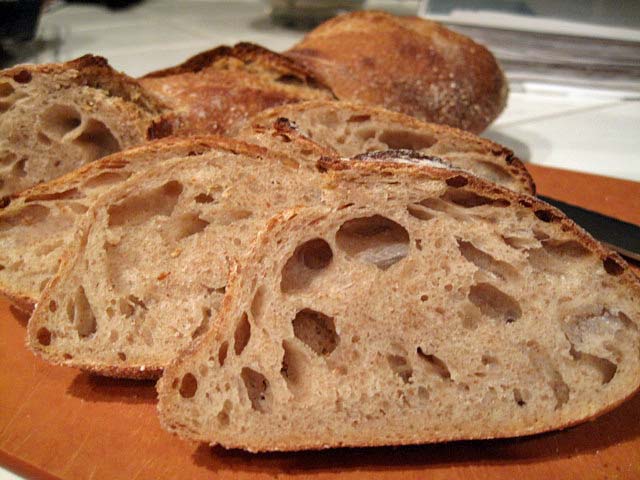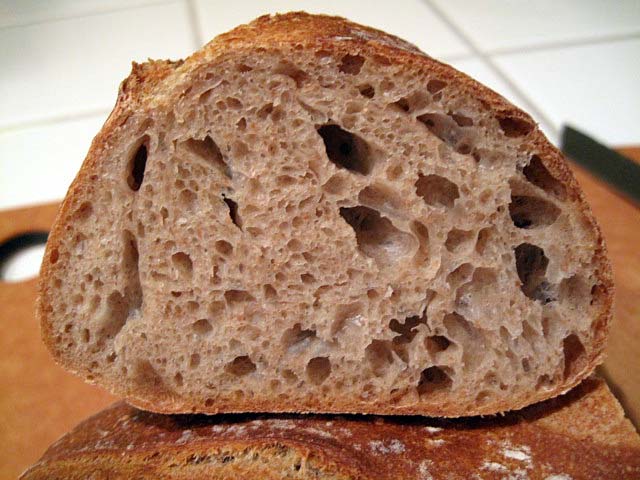
The "San Joaquin Sourdough" evolved from Anis Bouabsa's formula for baguettes. Most of my deviations developed in discussion on TheFreshLoaf.com with Janedo, who first suggested adding sourdough starter and rye, and, then, leaving out the baker's yeast and making it as a "pure" pain au levain.
I have been using that formula – a 70-75% hydration dough with 90% white flour and 10% whole rye, raised with wild yeast – for the past 18 months, and it has been my favorite bread. However, I have recently begun using the mix of flours employed by Gérard Rubaud, as reported on Farine.com. The result is a bread with a wonderful aroma and flavor that can be easily made in two three to four hour blocks of time on two consecutive days.
San Joaquin Sourdough made with Gérard Rubaud's flour mix (Scaled for 1000 gms of dough)
|
Gérard Rubaud's flour mix
|
|
Flour
|
Baker's %
|
Levain
|
Final dough
|
Total dough
|
|
|
|
All Purpose
|
70
|
98
|
295
|
393
|
|
|
|
Whole Wheat
|
18
|
25
|
76
|
101
|
|
|
|
Spelt
|
9
|
13
|
38
|
51
|
|
|
|
Whole Rye
|
3
|
4
|
13
|
17
|
|
|
|
|
|
|
Total Flour
|
562
|
|
|
|
Total Dough
|
Baker's %
|
Weight
|
|
Flour
|
100
|
562
|
|
Water
|
76
|
427
|
|
Salt
|
2
|
11
|
|
|
Total
|
1000
|
|
Levain
|
Baker's %
|
Weight
|
|
Flour
|
100
|
140
|
|
Water
|
75
|
105
|
|
Active starter
|
20
|
28
|
|
|
Total
|
273
|
|
Final Dough
|
Baker's %
|
Weight
|
|
Flour
|
100
|
421
|
|
Water
|
76
|
322
|
|
Salt
|
2
|
11
|
|
Levain
|
58
|
246
|
|
|
Total
|
1000
|
Procedures
Mix the flours
Because the levain and the final dough use the same mix of four flours, it is most convenient to weigh them out and mix them ahead of time and use the mix, as called for in the formula.
Prepare the levain
Two days before baking, feed the starter in the evening and let it ferment at room temperature overnight.
Mixing
In a large bowl, mix the levain with the water to dissolve it. Add the flours and salt and stir to form a shaggy mass. Cover tightly and let rest (autolyse) for 20 minutes.
Using a rubber spatula or a plastic scraper, stretch and fold the dough 30 times, rotating the bowl 1/5 turn between each stroke. Cover tightly. Repeat this stretch and fold procedure 3 times more at 20 minute intervals.
After the last series of stretches and folds, scape the dough into a lightly oiled 2 quart/2 liter container and cover tightly. (I use a 2 quart glass measuring pitcher with a tightly fitting plastic lid manufactured by Anchor Glass.)
After 45 minutes, transfer the dough to a lightly floured board and do a stretch and fold. Return the dough to the bowl. Let it rest 45 minutes and repeat the stretch and fold on the board. Return the dough to the bowl.
Fermentation
Ferment at room temperature for an hour or until it has expanded 25% or so. If you are using a glass bowl or pitcher, you should see small bubbles forming in the dough. Then place in the refrigerator and leave it there for 21 hours.
Dividing and Shaping
Take the dough out of the refrigerator and scrape it gently onto a lightly floured work surface. Gently pat it into a rectangle. Divide as desired or leave in one piece. To pre-shape for a bâtard, fold the near edge up just past the center of the dough and seal the edge by gently pressing the two layers together with the ulnar (little finger) edge of your hand or the heel of your hand, whichever works best for you. Then, bring the far edge of the dough gently just over the sealed edge and seal the new seam as described.
Cover the dough with plastic wrap and/or a kitchen towel and let it rest for 30-60 minutes, with the seams facing up. (The time will depend on ambient temperature and how active your starter is. The dough should have risen slightly, but not much.)
To shape a bâtard, fold the near edge of the dough and seal the edge, as before. Now, take the far edge of the dough and bring it towards you all the way to the work surface and seal the seam with the heel of your hand. Rotate the loaf gently toward you 1/4 turn so the last seam you formed is against the work surface and roll the loaf back and forth, with minimal downward pressure, to further seal the seam. Then, with the palms of both hands resting softly on the loaf, roll it back and forth to shape a bâtard. Start with both hands in the middle of the loaf and move them outward as you roll the loaf, slightly increasing the pressure as you move outward, so the bâtard ends up with the middle highest and the ends pointed .
Preheating the oven
One hour before baking, place a baking stone on the middle rack and prepare to steam the oven. Heat the oven to 500F.
Proofing
After shaping the loaf, transfer it to parchment paper liberally dusted with semolina or a linen couche, liberally dusted with flour. Cover the loaf with plastic wrap and a kitchen towel or a fold of the linen. Proof until the loaf has expanded to about 1-1/2 times it's original size. (30-45 minutes) Do not over-proof, if you want good oven-spring and bloom!
Baking
Pre-steam the oven.
Slip a peel or cookie sheet under the parchment paper holding the loaf or transfer to a peel, if you used a couche. Score the loaf.
Transfer the loaf (and parchment paper, if used) to the baking stone, Steam the oven and turn the oven down to 460F.
After 12-15 minutes, remove your steam source from the oven. Rotate the loaf 180 degrees, if it is br
owning unevenly. Close the oven door.
Bake for another 12-15 minutes, then remove the loaf and place on a cooling rack. Check for doneness. (Nice crust color. Internal temperature of at least 205F. Hollow sound when you thump the bottom of the loaf.) If necessary, return to loaf to the oven to bake longer.
When the loaf is done, leave it on the baking stone with the oven turned off and the door ajar for 5-10 minutes to dry and crisp up the crust.
Cooling
Cool on a rack for two hours before slicing.


David


























